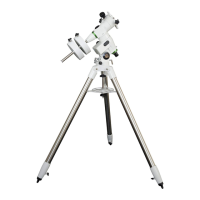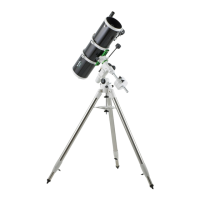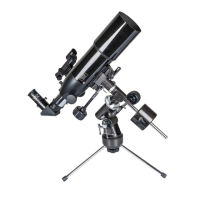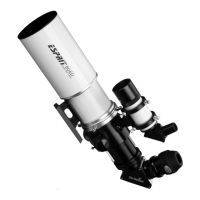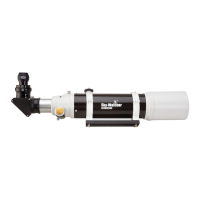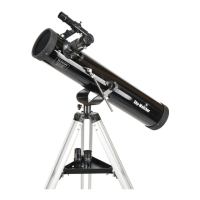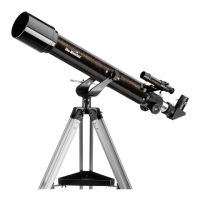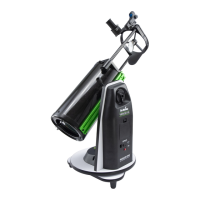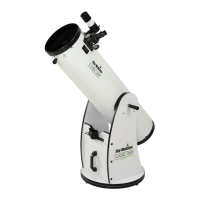12
In order for your telescope to track objects in the sky you
have to align your mount. This means tilting the head over so
that it points to the North (or South) celestial pole. For
people in the Northern Hemisphere this is rather easy as the
bright star Polaris is very near the North Celestial Pole. For
casual observing, rough polar alignment is adequate. Make
sure your equatorial mount is level and the red dot finder is
aligned with the telescope before beginning.
Setting the latitude
Look up your latitude on a map, road maps are good for this
purpose. Now look at the side of your mount head, there you
will see a scale running from 0-90 degrees. At the base of
the head, just above the legs, are two screws opposite each
other under the hinge. All you have to do is loosen one side
and tighten the other until your latitude is shown by the
indicator pointer (Fig.i).
P
olar
Alignmen
t
F
ocusing
Fig.h
Fig.i
Slowly turn the focus knobs under the focuser, one way or
the other, until the image in the eyepiece is sharp (Fig.h).
The image usually has to be finely refocused over time, due
to small variations caused by temperature changes, flexures,
etc. This often happens with short focal ratio telescopes,
particularly when they haven't yet reached outside
temperature. Refocusing is almost always necessary when
you change an eyepiece or add or remove a Barlow lens.
Fig.g
U
sing the Barlow lens (optional)
A Barlow is a negative lens which increases the magnifying
power of an eyepiece, while reducing the field of view. It
expands the cone of the focussed light before it reaches the
focal point, so that the telescope's focal length appears
longer to the eyepiece.
The Barlow is inserted between the focuser and the
eyepiece in a reflector, and usually between the diagonal
and the eyepiece in a refractor or a Maksutov (Fig.g). With
some telescopes, it can also be inserted between the
focuser and the diagonal, and in this position it gives even
greater magnification. For example, a 2X Barlow when
inserted after the diagonal can become 3X when placed in
front of the diagonal.
In addition to increasing magnification, the benefits of using
a Barlow lens include improved eye relief, and reduced
spherical aberration in the eyepiece. For this reason, a
Barlow plus a lens often outperform a single lens producing
the same magnification. However, it is greatest value may be
that a Barlow can potentially double the number of
eyepieces in your collection.
Barlow
Diagonal
Eyepiece
(Refracting Telescopes
and Maksutovs)
(Reflecting Telescopes)
Barlow
Eyepiece
0
10
20
30
40
50
60
70
80
90
Latitude scale

